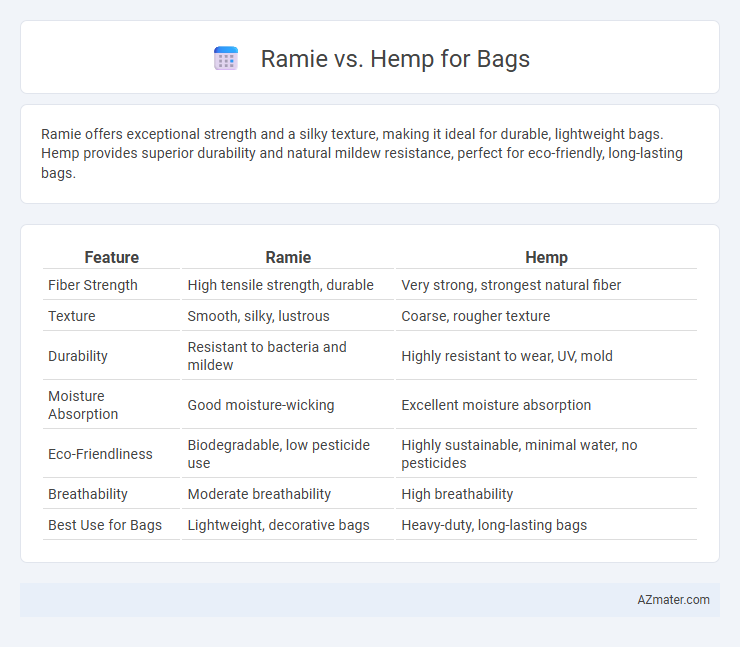Ramie offers exceptional strength and a silky texture, making it ideal for durable, lightweight bags. Hemp provides superior durability and natural mildew resistance, perfect for eco-friendly, long-lasting bags.
Table of Comparison
| Feature | Ramie | Hemp |
|---|---|---|
| Fiber Strength | High tensile strength, durable | Very strong, strongest natural fiber |
| Texture | Smooth, silky, lustrous | Coarse, rougher texture |
| Durability | Resistant to bacteria and mildew | Highly resistant to wear, UV, mold |
| Moisture Absorption | Good moisture-wicking | Excellent moisture absorption |
| Eco-Friendliness | Biodegradable, low pesticide use | Highly sustainable, minimal water, no pesticides |
| Breathability | Moderate breathability | High breathability |
| Best Use for Bags | Lightweight, decorative bags | Heavy-duty, long-lasting bags |
Introduction: Ramie vs Hemp for Bags
Ramie and hemp are two natural fibers commonly used for crafting durable, eco-friendly bags. Ramie, derived from the stalks of the Boehmeria plant, offers a silky luster and strong tensile strength, making it suitable for stylish, lightweight bags. Hemp, sourced from the Cannabis sativa plant, is known for its exceptional durability, resistance to mold, and biodegradability, ideal for heavy-duty and sustainable bag designs.
Overview of Ramie and Hemp Fibers
Ramie fibers, derived from the stalks of the Boehmeria plant, are known for their silky luster, high tensile strength, and excellent durability, making them suitable for sturdy yet lightweight bags. Hemp fibers, sourced from the stalks of the Cannabis sativa plant, offer strong, coarse texture with natural resistance to UV light, mold, and mildew, providing longevity and eco-friendliness for sustainable bag production. Both fibers boast biodegradability and abrasion resistance, but hemp's higher elongation and moisture-wicking properties contribute to better flexibility and comfort in everyday use.
Cultivation and Sustainability Comparison
Ramie cultivation requires minimal pesticides and grows rapidly in warm, humid climates, making it an eco-friendly fiber option with high yield per acre. Hemp thrives in diverse soil conditions, needs less water, and improves soil health through phytoremediation, enhancing sustainability in crop rotation systems. Both fibers offer biodegradable and renewable materials, but hemp's lower resource input and faster growth cycle generally result in a smaller environmental footprint for bag production.
Fiber Strength and Durability
Ramie fibers exhibit high tensile strength, often surpassing hemp by up to 20%, making ramie a strong choice for durable bags. Hemp fibers are valued for their toughness and abrasion resistance, contributing to long-lasting bag materials that maintain integrity under heavy use. Both fibers offer excellent durability, but ramie's superior fiber strength provides enhanced resilience against wear and tear in bag applications.
Texture and Appearance Differences
Ramie fibers produce a lustrous, silky texture with a fine, smooth appearance, making bags feel soft yet durable, while hemp fibers are coarser and have a rougher texture that lends a rugged, natural look to bags. Ramie fabric often exhibits a shiny surface that enhances visual appeal, whereas hemp offers a matte finish with visible fiber irregularities for a rustic aesthetic. These differences impact the tactile experience and style, with ramie bags appearing more refined and hemp bags showcasing a sturdy, earthy character.
Water Absorption and Weather Resistance
Ramie fibers exhibit higher water absorption, making them prone to retaining moisture, which can affect durability when exposed to wet conditions. Hemp fibers demonstrate superior weather resistance with low water uptake and natural antifungal properties, enhancing bag longevity in humid or rainy climates. Choosing hemp for bags is ideal when prioritizing moisture management and outdoor durability.
Environmental Impact of Ramie and Hemp
Ramie and hemp are both sustainable fibers with low environmental impact, but hemp generally requires less water and fewer pesticides during cultivation compared to ramie, making it more eco-friendly. Ramie, derived from the stalks of the Boehmeria plant, demands more energy-intensive processing for fiber extraction, contributing to a higher carbon footprint. Hemp's rapid growth cycle and ability to improve soil health through phytoremediation further enhance its environmental sustainability for bag production.
Cost and Market Availability
Ramie and hemp fibers both offer durability for bag manufacturing, but hemp generally incurs higher initial costs due to extensive cultivation and processing requirements. Ramie is more cost-effective with a growing market presence in Asia, benefiting from quicker harvest cycles and lower labor expenses. Hemp's global market availability is expanding rapidly, driven by increasing demand in eco-friendly textiles, while ramie's market remains more niche but steadily growing in sustainable fashion sectors.
Best Uses: Which Fiber for Which Bag?
Ramie is an ideal fiber for lightweight, breathable bags such as tote bags and shopping bags due to its silky luster and moisture-wicking properties. Hemp, known for its exceptional strength and durability, is best suited for heavy-duty bags like backpacks and messenger bags designed for long-term use. Choosing between ramie and hemp depends on the bag's intended function and required durability, making ramie perfect for aesthetic, everyday carry bags and hemp for rugged, high-load applications.
Conclusion: Choosing Between Ramie and Hemp
Hemp offers superior durability, moisture resistance, and eco-friendliness, making it ideal for heavy-duty bags and sustainable fashion. Ramie provides a softer texture and a smooth finish, suitable for lightweight and stylish bag designs. Choosing between ramie and hemp depends on the bag's intended use, balancing strength and aesthetic preferences for optimal performance.

Infographic: Ramie vs Hemp for Bag
 azmater.com
azmater.com